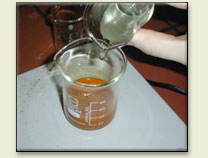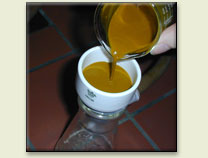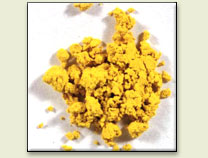How Cobalt yellow is made:
| Artificial variety of pigment | Reaction of cobaltous salts with acetic acid and subsequent mixing with concentrated solution of potassium nitrite. |
| In the lab | |
| Materials needed: | Cobalt(II)-chloride (CoCl2 · 6H2O), potassium nitrite (KNO2), acetic acid |
| Safety (MSDSs): | Cobalt(II) chloride, potassium nitrite, acetic acid (at Fisher Scientific) |
| Method: | 1 g of cobalt(II)-chloride is solved in 20 ml of deionized water and acidified with approximately 1 ml concentrated acetic acid. 8 g potassium nitrite is then solved in 20 ml of deionized water and slowly added to the cobalt chloride solution. The resulting precipitate is washed and filtered off. |
Illustration of the process:
Making cobalt yellow in the lab
 |
 |
|
|
|
The ground pigment:
Pile of ground Cobalt yellow

Other yellows
(intro) - Cadmium yellow/red - Chrome yellow - Cobalt yellow - Indian yellow - Lead-tin yellow - Lemon yellow - Naples yellow - Orpiment - Yellow ochre
(intro) - Cadmium yellow/red - Chrome yellow - Cobalt yellow - Indian yellow - Lead-tin yellow - Lemon yellow - Naples yellow - Orpiment - Yellow ochre

